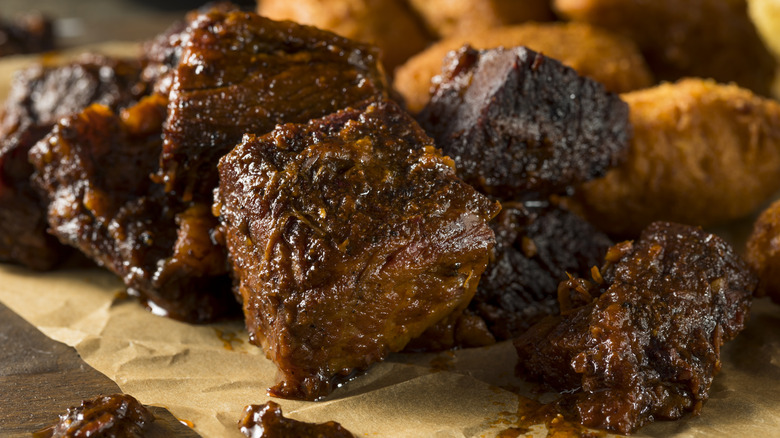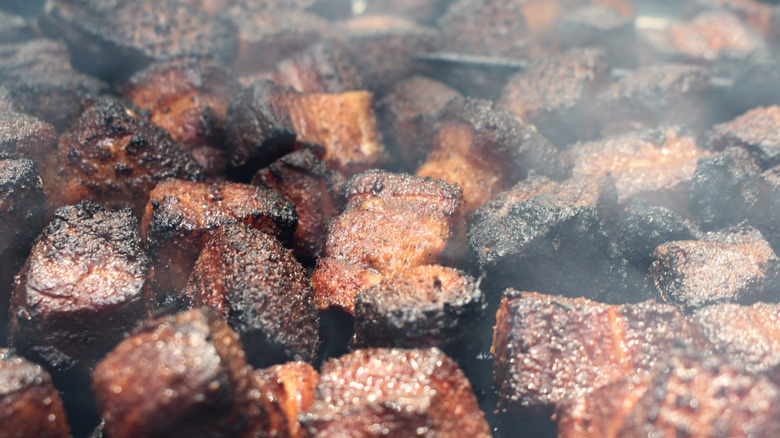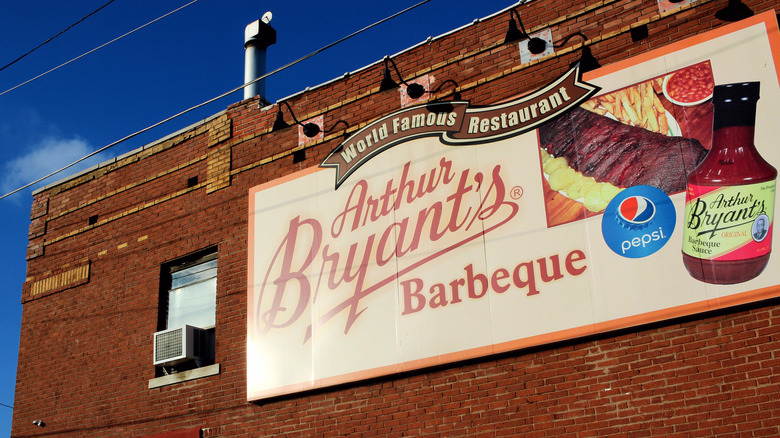What Are Burnt Ends, Anyway?
Barbecue is basically alchemy, except that it works. Instead of a fruitless quest to transform mundane metals into gold, barbecue transforms the toughest and fattiest cuts at the butcher shop into meaty marvels worthy of the highest culinary honors. Now, when we talk about barbecue, we don't mean throwing some burgers or steaks on a grill — there's a big difference between grilling and barbecue. Grilling is about high heat and fast cooking, but barbecue embraces a low-and-slow approach. Only by this gentle method can the connective tissue in cuts like ribs and brisket break down into tender delights. There was a time when these cuts were discarded by butchers, letting untold amounts of valuable meat go to waste, but the art of barbecue saved them.
No dish better exemplifies this transformation from rejection to reverence than burnt ends. Some people may be unfamiliar with this treat because it isn't as famous and widespread as other barbecue classics, but once you've tasted burnt ends it's easy to see why they could be considered a pitmaster's favorite. There's simply nothing else like them. The little beef nuggets are smoked to the point of forming a thick black crust that adds a unique, almost crunchy texture and strong umami flavor boost. If you've eaten smoked brisket, you're surely familiar with the smoke ring and the thin layer of bark along the edges of each slice. Well, imagine if that was the entire cut in and of itself.
The lowdown on burnt ends
Burnt ends are made from the least-desirable part of one of the least-desirable parts of the cow, that being the tough and fatty brisket, which comes from a cow's hard-working pectoral muscles. A whole brisket (also known as a packer brisket) is divided into two segments: the flat and the point. You're probably familiar with the flat, which comprises a majority of the brisket, as it is the most commonly sold cut. It's long, maintaining a relatively even thickness from end to end, and is used to make classic brisket dishes such as pastrami and corned beef. The brisket point, on the other hand, has far more fat and connective tissues in it, posing a bigger challenge to cooks.
Burnt ends give new purpose to the point end of a brisket after the pitmaster has used up the flat end. Making burnt ends begins by smoking the whole packer brisket, a slow process that typically takes around four to six hours at low heat. Once the brisket is finished, the flat and the point can be separated, with the former being sliced and often doused in barbecue sauce for serving. The leftover point meat is then cut into approximately 1-inch cubes, which are tossed in barbecue sauce and returned to the smoker for another hour or two. During this second cook, the sauce caramelizes, intensifying its flavor, while the bark along the edges of the beef crisps up and darkens, hence the "burnt" name.
The history of burnt ends
The only problem with burnt ends is that they don't appear on every barbecue restaurant's menu. They are unique to Kansas City-style barbecue, and while there are restaurants around the country that serve burnt ends, they're not nearly as common as items like baby back ribs and sliced brisket. We can actually trace the story of burnt ends to one specific restaurant in Kansas City, the venerated holy land of meat known as Arthur Bryant's Barbeque. Its namesake, Arthur Bryant, got his start working for Henry Perry (widely known as the "father of Kansas City barbecue") before taking over Perry's business in the 1940s, reworking the old sauce recipe, and naming the spot after himself. Bryant helmed the establishment until his death in 1982, but the restaurant is still thriving to this day, thanks in no small part to its burnt ends.
Burnt ends weren't always on the menu at Arthur Bryant's. In fact, they were originally offered as free samples. Cooks would chop up whole briskets for platters and sandwiches, setting aside the uneven chunks of the point end as they did so. When the customers placed their orders at the counter, they could grab a handful of the meaty bites to snack on while they waited. Burnt ends only achieved national attention in 1972 when writer Calvin Trillin wrote a review of Arthur Bryant's in Playboy magazine, declaring their best item to be the free brisket edges you grabbed at the counter.


